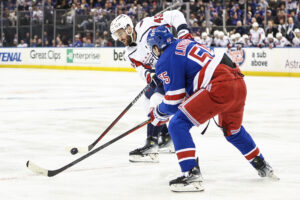The Toronto Maple Leafs power play hasn’t had a lot of success this season. A team of this talent should have no problems on the man advantage, yet, they currently rank 18th among the 31 teams, scoring on just 18.2 percent of their chances.
Optimizing the Toronto Maple Leafs Power Play
Changes From the 2018-19 Season to 2019-20
Last season the Leafs power play ranked eighth in the league that scored on 21.8 percent of their opportunities. Now, the Leafs drop 10 spots and 3.6 percent so far this season. The changes may not seem that big at first when you look at a basic overview. The only real change is that Nazem Kadri is no longer on the top unit. He was instead dealt to the Colorado Avalanche and has been replaced by Andreas Johnsson on the Leafs top unit. Other than that, it’s a fairly similar-looking group making up the top unit. With Jim Hiller leaving as the team’s power-play coach and Paul McFarland joining in his place, this is the other major change to the Leafs.
Last season, the Leafs were able to generate lots of high danger chances in close, but this season that statement isn’t as true.
This Year


The Leafs quality directly in front of the net is effectively non-existent compared to last season, but the shots from the point have increased significantly. These low-quality chances are not what a team should be attempting when on the man advantage, rather using the blue line as an outlet. If the player at the top of the zone wants to take a shot, they should move closer to a higher danger area as the center falls back and covers them. When the Leafs do take shots from the point, it seems to end up getting blocked and come out of the zone, wasting time or even creating a chance the other way.
The Leafs are also not generating the same quantity as last season, where they led the league in corsi for per 60 with 112.53. That’s approximately 3.75 shot attempts per two minutes. This season, it’s down to 98.28 (3.28 per two minutes). While not seeming like a lot, it points to the issues with the Leafs. They have consistently struggled to gain the zone with the drop pass play this season.
Fixing the Quantity Issues
Currently, when all are healthy, William Nylander is not on the top power-play unit. He did make an appearance when Mitch Marner and John Tavares suffered injuries, but when the season started and all the players they use on the top unit were healthy, Nylander was not a part of it. Adding Nylander, the Leafs best player in terms of zone entries, as a regular on the top unit is a good place to start. So, ideally, the top unit would consist of Tavares, Nylander, Marner, Auston Matthews and one of Tyson Barrie or Morgan Rielly.
Thanks to the work of Arik Parnass, we know the value of zone entries on power plays. Entering the zone cleanly leads to more shot attempts. He discovers the use of the drop pass is an extremely viable way of gaining the zone on the power play. So if the drop pass is so good, and the Leafs use it, why are their chances down from last season? The issue could be with predictability. In order to do this less predictable, the Leafs will have to create more options. Option availability is going to be an overarching theme of improving the Toronto Maple Leafs power play, and that’s because the more options a team has, the less predictable the power play will be.
How The Leafs Should Implement the Drop Pass
To start the rush, the back (either Rielly or Barrie) will carry the puck through the neutral zone and have both Nylander and Marner fall back. This allows for two options on the drop pass. Both Marner and Nylander are great at entering the offensive zone with puck control, which is why it’s best to have these two players as options to receive the drop pass.
With two players back, this allows either Marner or Nylander to have a lateral passing option, and it just so happens that these are the two best passers on the team as well. This generates multiple options from just one formation. Of course, it won’t work out this perfectly each time, but having both Nylander and Marner as options to work with the drop pass should effectively help the Leafs gain the zone more often.
Gaining the zone, and gaining the zone quickly should help them generate more shot attempts per powerplay. The Leafs seem to currently use the drop pass, and only Marner collects and cuts through the neutral zone. By having different options, and options to pass the Leafs can make it ambiguous how they’re going to enter with the same strategy at the core.
Fixing the Quality Issue
The Easy Way
The quality issue is seemingly easier to fix than the zone entries. To be put simply, the Leafs should stop taking shots from the point. It’s a low danger area of the ice, and cycling it back to the point should be used as an outlet that can pass it to someone in a better position. If the player really feels like they want to shoot at the point, they should skate it in and have someone fall back to cover. This is an easy way to generate higher quality chances without changing much of the in-zone attack.
The Hard Way
The more complicated way would be reconfiguring the structure of the entire power play. Mitch Marner is an excellent passer, no one will deny that. His shot, on the other hand, leaves something to be desired. Placing Marner down below the goal line allows him to still play to his strengths with passing, but won’t let him shoot. Keeping Matthews on the right side is ideal, as it lets him take that wicked shot everyone knows he has and allows him to get off a one-timer quickly still.
On the right side, replacing Marner, Nylander would be slotted in. Nylander is an excellent passer. Not as good as Marner, but the gap is closer than most would think. He also has a better shot than Marner does. By placing him there, you lose some slight passing ability but gain the option to have a shot come from that side as well. It gives this power-play another option to use. Tavares and the D roles remain unchanged.
This new formation allows for some of the most dangerous passes, such as royal road and behind the net. These plays lead to some of the highest shooting percentages out of any other type of passes and would come from much more dangerous shot locations than from the point.
Power Play Usage
The Leafs currently split their power-play time approximately 50/50 amongst their two units. This is fine with even talent distribution. With the Leafs top-loading, their power play but only using it half the time, it’s putting yourself at a relative disadvantage. The Leafs need to ride their top power-play unit more if this is the strategy they are using. Teams like the Washington Capitals, their top player Alex Ovechkin has spent a total of 86:06 on the power play this season. The Capitals have been on the power play for just under 99 minutes. This is how the Leafs should look at utilizing their top players.
A lot of this article was written with the use of Ryan Stimson’s book, Tape to Space: Redefining Modern Hockey Tactics.
Main photo:
Embed from Getty Images






